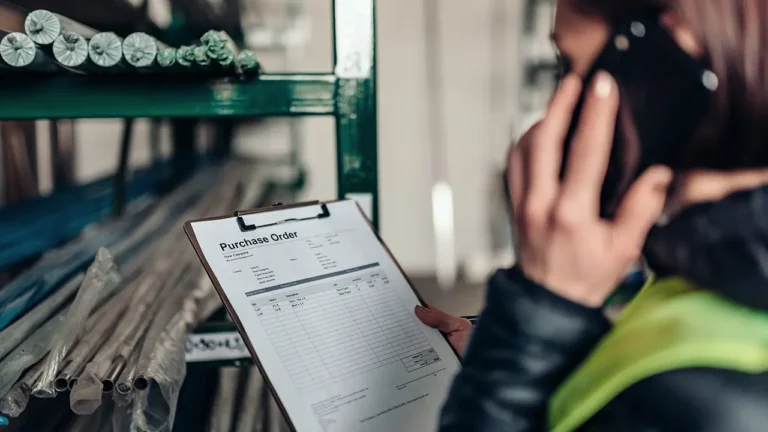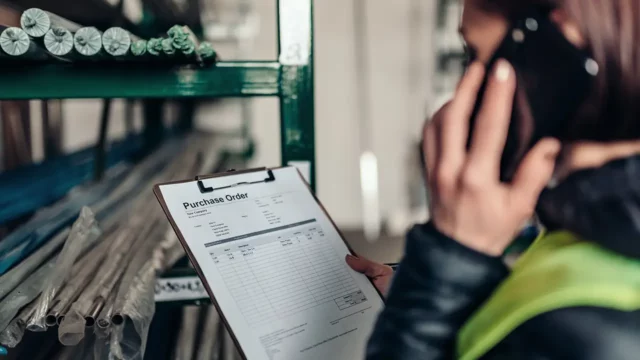Purchase Order Template Download

Purchase Order Template Download
Good documentation is a major player in preventing chaos in the accounting department. This is especially true when it comes to accounting’s involvement in purchasing, as even small businesses generate dozens or hundreds of purchase orders each month. A strong purchase order system is essential for keeping the details associated with purchasing, invoicing, and inventory management on track.
Relying on a great purchase order form template is a real life-saver for busy stakeholders trying to source the things their business needs. Today, we’ll cover many of the top questions about the purchase order process, including:
- What is a purchase order form?
- Why is a purchase order important?
- What is the difference between an invoice and a purchase order?
- Is a purchase order the same as an order form?
- What are the steps to creating a purchase order?
- How do you complete a purchase order template?
- How do you send a purchase order to a supplier?
Download the free tool: Purchase Order Template
What is a purchase order?
A purchase order (PO) is a formal document issued by a buyer to a seller that outlines the products, services, pricing, and terms of a purchase. It serves as an agreement between both parties when placing orders and acts as a legal contract for the transaction.
Purchase orders contain item descriptions, quantities, payment terms, and delivery dates. They also include other important information, such as taxes or shipping fees that may need to be paid by either party. A purchase order is typically generated using software and is usually signed off on by both parties before any goods or services are delivered or invoiced.
Most purchase orders use a template to ensure all order information is complete and accurate. Many businesses use Google Sheets, a Microsoft Excel template, or a proprietary system to create a form for general use.
Is a purchase order the same as an order form?
A purchase order is not the same as an order form because a purchase order is legally binding and serves as a contract between two parties. An order form, on the other hand, is simply an itemized list of goods or services requested. It does not have any legal power or contractual obligations attached to it. Additionally, a purchase order typically includes payment terms and delivery details not usually found in an order form.
A purchase order includes several specific elements for tracking the order, such as a PO number, payment info, terms and conditions, order details, shipping method, shipping terms, and other information vital to processing the transaction.
What is the difference between an invoice and a purchase order?
An invoice is a document a seller issues to a buyer that serves as a bill for goods or services. It typically lists each item's price, applicable taxes, and the grand total of all items purchased. The purchase order, once completed, prompts the processing of the invoice for payment.
Benefits of a strong purchase order process
Purchase orders are an important source of information and documentation for your procurement process. They outline vital information for every purchase, create a paper trail for order research, and ensure that the items you purchase are the same as those you receive.
Legality: Purchase orders serve as a legally binding agreement between two parties and provide protection in the case of a dispute about the goods. They establish the parameters of a sale and outline the responsibilities of each party in the transaction.
Accuracy: The body of a purchase order provides an itemized list of goods or services requested. This ensures orders are fulfilled correctly, the goods match those agreed upon, and the pricing of those goods is consistent with the items you receive. Accurate purchase orders also eliminate costly cash leaks from your procurement process.
Payment: Purchase orders outline the payment terms and conditions of the supplier. They list the repayment terms for orders with net terms and itemize any fees, delivery charges, or late charges that may apply to the purchase.
Documentation: Purchase orders ensure accuracy and efficiency in the procurement process by providing detailed information for each transaction. This enables matching between the purchase requisition, purchase order, bill of lading or packing slip, and invoice.
Visibility: The information on the purchase order informs many other finance and accounting processes, including order tracking, payments, spend analysis, price benchmarking, and vendor performance management.
What are the important components of a purchase order?
Although the template for purchase orders may vary between companies, every purchase order should feature several key components for completeness and order tracking.
Internal stakeholder information: Purchase orders should have the company's name and the person or department submitting the purchase order (in case of any questions or communication needs during processing). It should also have contact information for the AP department.
Vendor information: Each purchase order should include the vendor’s name, business address, phone number, fax number, and sales representative or AR contact’s information.
Order details: Include the order date, purchase order number, and an itemized list of products and services on each PO to prevent discrepancies between orders and receipts, unauthorized payments, and vendor fraud. POs offer clear records of all items and costs for effective budgeting.
Payment details: Including vendor payment information is part of arranging proper payments. It’s also integral to document payment terms and methods to ensure timely payment, which can cut down on the over 20 percent of invoice exceptions businesses face when processing payments. Acceptable forms of payment or preference for electronic payment should be noted, as should any early payment discounts negotiated during the sale.
Terms and conditions: The general terms and conditions of the purchase should appear on the PO for reference. In the event of issues or discrepancies, the PO serves as the final legal word on the terms agreed upon by the parties.
What are the steps to create a purchase order process?
Creating a purchase order should be a documented, repeatable process. This ensures the PO is accurate and complete each time.
Use these steps to ensure strong purchase order management for your organization. By relying on a template, you highlight all necessary information to guarantee it’s included in every transaction:
1. Terms negotiation
Vendor management includes negotiating terms and conditions for purchases, such as payment details and delivery dates. The cost of goods or services should also be documented in detail, along with any agreed-upon discounts.
2. Submit the purchase requisition or intake form
Once all information is settled, the buyer generates a purchase requisition or purchase order document that includes all negotiated details. They then submit the document for approval from internal departments, including their direct manager and any legal, IT, security, or finance team reviewers. Once approved, the accounting team creates the purchase order.
3. Issue purchase order to the vendor
Once internal approval is complete, the accounting team produces and submits the purchase order to the vendor. The vendor then reviews and accepts the purchase order before preparing to fulfill the order. The vendor’s review process also ensures that they understand what is in the order and verifies that the correct items and quantities are available.
4. Fulfillment and review
The vendor fulfills the order according to the details in the PO and delivers the order to the buyer. The buyer verifies the shipped goods against the data in the PO and invoice. This review process allows the buyer’s receiving team time to check for incorrect, damaged, or poor-quality products, all of which cost companies big, with an average of 8 percent of inventory getting wasted annually. Once approved, accounting pays the invoice and completes the transaction according to the terms outlined in the agreement.
5. Documentation
Once the transaction is complete, a strong procurement process also includes centralizing the purchase data into a platform for future use. This allows teams to review historical purchase data, compare prices year-over-year, and evaluate vendor performance. Purchase order software tools and procurement platforms make this process significantly easier and more accurate.
Make purchase orders easier with a procurement platform
A procurement platform like Order.co enables automation throughout the purchasing process. With a few clicks, users can generate a single purchase request across multiple vendors, get the necessary approvals, and submit their POs to the vendors electronically. Received goods are easily tied back to the PO and invoice data, saving hours of manual reconciliation. A platform also makes it easier for accounting teams to review transactions, research issues, and account for every purchase at month-end.
Order.co offers robust features to automate and streamline purchasing while maintaining optimal spend controls:
- Automatic GL coding and three-way for easy recording and reconciliation
- Advanced budgeting and audit trail features to ensure accurate, well-maintained reporting
- Rules-based approvals and dynamic spend guidelines to ensure purchase policy compliance in every transaction
- Automatic PO generation and order tracking for accuracy and visibility throughout the purchasing process
To see the power of purchase order automation, request a demo of Order.co.
Get started
Schedule a demo to see how Order.co can simplify buying for your business.
"*" indicates required fields


![7 Benefits to Building a Solid Procurement Strategy & How To Do It [2023]](https://www.order.co/wp-content/uploads/2023/04/iStock-1188425195-640x360.webp)
